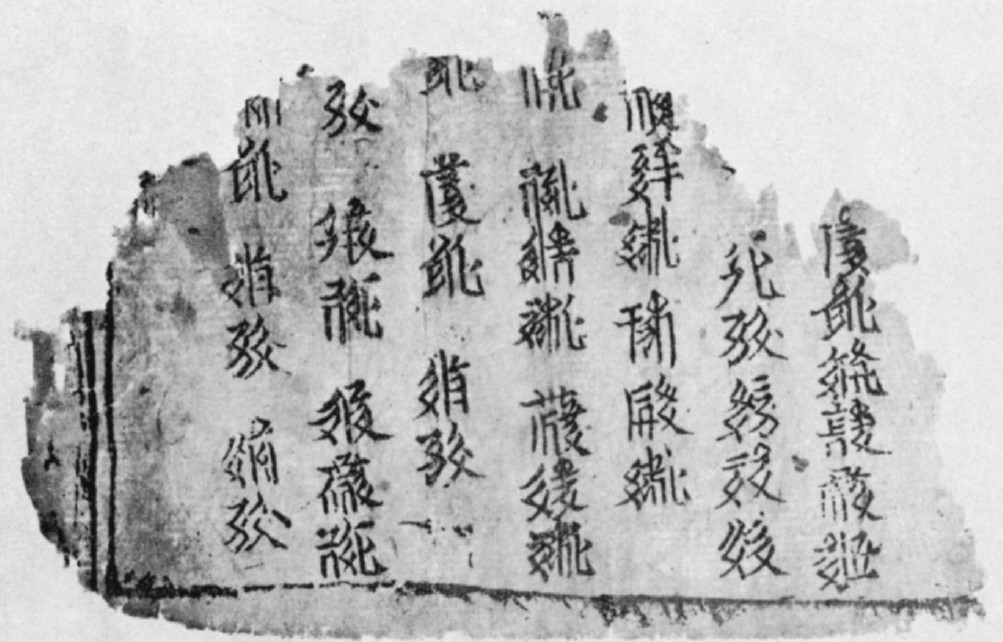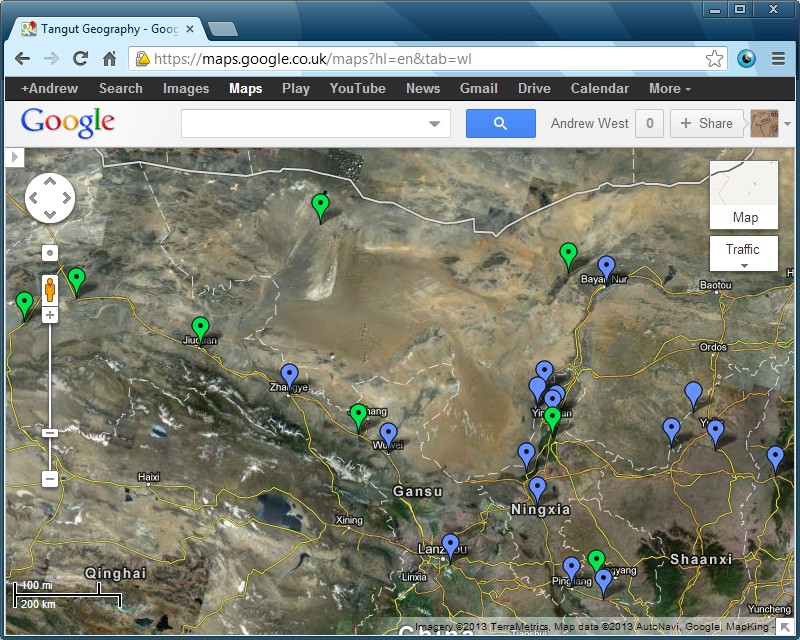Something I have always wanted to see is an original 12th or 13th century map of the Western Xia territory with place names written in the Tangut script. Unfortunately, as far as I know, no such map exists any longer. However, there is a Chinese map of the Western Xia territory (entitled the Western Xia Topographic Map 西夏地形圖) that probably dates back to the late Northern Song (circa 1108), although extant editions were printed between 1608 and 1895 :
- Map included in the Collected Works of Fan Wenzheng in a Ming Wanli 36 (1608) edition of The Collections of Two Famous Song Dynasty Ministers (宋兩名相集), held at the National Library of China in Beijing
- Map included in a Ming Wanli 37 (1609) edition of the Collected Works of Fan Wenzheng (重校范文正公集), held at Peking University Library
- Map collected from China in the late 19th century by Konstantin Andreianovich Skachkov (1821–1883), held at the Russian State Library in Moscow
- Map included in Zhang Qian's 張鑒 1895 Chronological History of the Western Xia 西夏紀事本末
Modern Redrawing of Zhang Qian's 1895 version of the Western Xia Topographic Map
As far as I know, there are no surviving examples of Tangut geographic or topographic works, but parts of the Western Xia Law Codes enumerate administrative divisions and list various place names. 150 fragments of the Western Xia law codes as established during the Celestial Prosperity era (1149–1169), collected from Kharakhoto by P. K. Kozlov in 1909, have been compiled by E. I. Kychanov and published as The Revised and Newly Endorsed Code for the Designation of Reign ‘Celestial Prosperity’ (1149-69)in 1989. Unfortunately, I have not had the opportunity to see this book, but yesterday I came across a fragment of a page from a printed edition of the Western Xia law codes collected by Aurel Stein from Kharakhoto in Eric Grinstead's 1961 discussion of "Tangut Fragments in the British Museum" :
Fragment of an edition of the Western Xia Law Codes held at the British Library (original no. K.K. II. 0227.n)
This fragment consists of lists of Western Xia place names. I have transliterated and translated these in the table below :
| Line | Tangut Character | Reconstructed Reading (Li Fanwen 2008) | Meaning | Translation |
|---|---|---|---|---|
| 1.1 |  | *zjɨr | "south" 南 | Southern Court 南院 (an administrative department) |
| 1.2 |  | *iọ | "court" 院 | |
| 1.3 |  | *mjijr | "palace" 宮 | Mobile Palace 行宮 |
| 1.4 |  | *bji̱j | "to travel" 行 | |
| 1.5 |  | *dzjɨ | "to provide" | "three offices" 三司 = "State Finance Commission" |
| 1.6 |  | *ka̱r | "steelyard" (a balance) | |
| 2.1 |  | *śia | Transcribes Chinese sha 沙 "sand" | Shazhou 沙州 (modern Dunhuang in Gansu) |
| 2.2 |  | *tśjiw | Transcribes Chinese zhou 州 "prefecture" | |
| 2.3 |  | *kjij | Transcribes Chinese jing 敬, 經, jin 近, etc. | Fiscal Commission 經治司 |
| 2.4 |  | *tśji | Transcribes Chinese zhi 至, 治, 志, etc. | |
| 2.5 |  | *sə | Transcribes Chinese shi 氏, si司, 斯, etc. | |
| 3.1 |  | *da | Transcribes Chinese lin 臨, 林, etc. | Linhe County 臨河縣 (modern Bayannur in Inner Mongolia) |
| 3.2 |  | *xụ̃ | Transcribes Chinese hong 紅 "red", 洪, 弘, he和, 河 etc. | |
| 3.3 |  | *xjwã | Transcribes Chinese xian 縣 "county" | |
| 3.4 |  | *po | Transcribes Chinese bao 堡 "fort", 保, 包, etc. | Baojing County 保靜縣 (in the viscinity of modern Wanghong 望洪 inYongning County in Ningxia) |
| 3.5 |  | *tshjɨj | "purple"; also transcribes Chinese qian 倩,qing 青, jing 靜, etc. | |
| 3.6 |  | *xjwã | Transcribes Chinese xian 縣 "county" | |
| 4.1 |  | *ljạ | to pierce (also used in place names) | ? |
| 4.2 |  | *wjij | Transcribes Chinese wen 温,yong 永, ying 穎, etc. | Yongchang County 永昌縣 (modern Yongchang County in Gansu) |
| 4.3 |  | *śjow | "to guard"; also transcribes Chinese shang尚, chang 昌, etc. | |
| 4.4 |  | *xjwã | Transcribes Chinese xian 縣 "county" | |
| 4.5 |  | *khej | "luxuriant"; also transcribes Chinese kai 開, 凱, etc. | Kaibian County 開邊縣 (in the viscinity of modern Zhenyuan Countyin Gansu) |
| 4.6 |  | *pjɨj | Transcribes Chinese bian邊 "border" | |
| 4.7 |  | *xjwã | Transcribes Chinese xian 縣 "county" | |
| 5.1 |  | *iọ | "court" 院 | ... Court ...院 |
| 5.2 |  | *zjɨr | "south" 南 | Southern Court 南院 (an administrative department) |
| 5.3 |  | *iọ | "court" 院 | |
| 5.4 |  | *su | "to plot"; also transcribes Chinese su 肅 | Suzhou 肅州 |
| 5.5 |  | *tśjiw | Transcribes Chinese zhou 州 "prefecture" | |
| 6.1 |  | *tśjiw | Transcribes Chinese zhou 州 "prefecture" | ...zhou ...州 |
| 6.2 |  | *zjɨ̱r | "water" 水 | Black Water 黑水. The Ejin River in Gansu and Inner Mongolia, perhaps referring specifically to the Tangut fortress city ofKharakhoto (黑水城), known to Marco Polo as Etzina. |
| 6.3 |  | *nja̱ | "black, dark" 黑 | |
| 6.4 |  | *•ow | Character used in Tangut surnames, of uncertain meaning here | Black Mountains (the Wolf Mountains or the western part of the Yin Mountains 陰山 in Inner Mongolia). Transcribed in Chinese as 午腊蒻 wǔlàruò in the History of the Song Dynasty 宋史 vol. 485 (see Nie Hongyin 2008). |
| 6.5 |  | *rar | "hill, mountain" 山 | |
| 6.6 |  | *nja̱ | "black, dark" 黑 | |
| 7.1 |  | *lji | "west" 西 | Western Court 西院 (an administrative department) |
| 7.2 |  | *iọ | "court" 院 | |
| 7.3 |  | *su | "to plot"; also transcribes Chinese su 肅 | Suzhou 肅州 |
| 7.4 |  | *tśjiw | Transcribes Chinese zhou 州 "prefecture" | |
| 7.5 |  | *kiwa | Transcribes Chinese gua 瓜, 寡, etc. | Guazhou 瓜州 (modern Guazhou County in Gansu) |
| 7.6 |  | *tśjiw | Transcribes Chinese zhou 州 "prefecture" |
Having translated the above fragment, I thought it would be a fun idea to plot the place names mentioned in it on Google Maps, with the names given in Tangut script. This I have done on the map below, with place names taken from the British Library fragment indicated by green tags, and place names I have taken from other sources indicated by blue tags. Click on a tag to see the name of the place in Tangut characters.
Google Maps map showing Western Xia locations with place names in Tangut
Note 1. Some Tangut place names are written with different characters in different sources, and where this is the case one spelling has been arbitrarily chosen. For example, Suzhou 肅州 is written as 
 (*su tśjiw),
(*su tśjiw), 
 (*zu tśjiw) or
(*zu tśjiw) or 
 (*su tśjiw) in different sources.
(*su tśjiw) in different sources.

 (*su tśjiw),
(*su tśjiw), 
 (*zu tśjiw) or
(*zu tśjiw) or 
 (*su tśjiw) in different sources.
(*su tśjiw) in different sources.
Note 2. Tags without a dot in the middle indicate that the exact location of the place is uncertain or unknown.
Bibliography
- Grinstead, E. D., "Tangut Fragments in the British Museum"; The British Museum Quarterly vol. 24 nos. 3–4 (December 1961): 82–87.
- Huang Shengzhang 黄盛璋 and Wang Qianjin 汪前进, "New ideas about Xi Xia Di Xing Tu, the first and only map of Western Xia regime that has been handed down" 最早一幅西夏地图—《西夏地形图》新探; Studies in the History of Natural Sciences 自然科學史研究 vol. 11 no. 2 (1992): 177–187.
- Kychanov, E. I., The Revised and Newly Endorsed Code for the Designation of Reign ‘Celestial Prosperity’ (1149-69)Изменённый и заново утверждённый кодекс девиза царствования: Небесное процветание (1149-1169). Nauka, 1989.
- Nie Hongyin 聂鸿音, "Additional evidence on the Heishan Weifu Junsi" 黑山威福军司补证; Journal of Ningxia Teachers University (Social Science) 宁夏师范学院学报(社会科学) vol. 29 no. 4 (August 1008): 67–69.



No comments:
Post a Comment